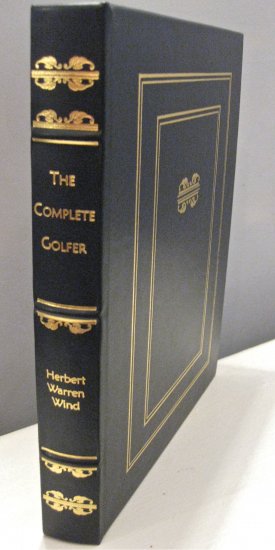The Complete Golfer (“Leather” Special)
Original price was: $179.00.$149.00Current price is: $149.00.
17% Off
Edited by Herbert Warren Wind
Odds are against you in most games of chance. But if you ever wanted a sure bet, give this book to any golfer as a gift. It is similar to lunch at Muirfield; many choices through many courses, all worthy of the finest table, and all shared convivially. As such, it is sure to satisfy every palate. Open The Complete Golfer anywhere and you are very likely to find something you enjoy. The reason is due largely to the wonderful choices made for this anthology by editor Herbert Warren Wind. A quality miscellany requires good selection by the compiler, a success often determined by their breadth of knowledge on the subject. Wind was in his best form in the early 1950s after writing The History of American Golf (a Classics of Golf title) and joining the staff of the New Yorker in 1949. He spent two years researching the literature of golf for his top picks in a variety of disciplines for this volume.
Bobby Jones writes in the original introduction, “Golf has more than enough in it to command the respect of any man.” Considerable literature will develop around such a game continues Jones, “History, humor, curiosities, stories of championships, essays on methods…and every golfer, I think, owes it to himself to have an acquaintance with this literature.”
To ease into this familiarity, Wind begins lightheartedly with fiction and a selection of cartoons. This seemingly innocent beginning is good preparation for the meatier third section The Spirit of the Game with history, comments, reminiscences and some humor. Francis Ouimet gives an intimate view of growing up across the street from the country club; how he would sneak on and play until discovered and chased by the greenkeeper. H. B. Martin tells us how golf came into American legitimacy with the 1888 formation of The Saint Andrew’s Golf Club in Yonkers, NY, and how the “Old Apple Tree Gang” received its name. Grantland Rice’s article for The American Golfer (see the Classics of Golf selection by the same title for many more articles) is one of the most insightful ever written on Bobby Jones’ preparation for his record-setting Grand Slam year. Rice prophetically closes The Prospect for 1930 with: “There is at least a first class chance that this will be the best year he has ever had, and that will mean the best year any individual golfer ever had.” If Jones is your cup of tea, you will read and reread Bernard Darwin’s The Immortal Bobby, one of the best pieces ever written on the man.
Another famous Jones, Robert Trent Jones, contributed an excellent chapter of substance on golf course architecture entitled From St. Andrews to the Modern American Courses. He offers an overview of the history of his craft but focuses on several modern courses to explain current theory. The discussions are facilitated by the inclusion of a series of color course maps. Pinehurst No. 2, Pine Valley, Merion, Pebble Beach, Augusta National, The National Golf Links, and Oakland Hills are detailed and studied in comparison with The Old Course. One other course is omitted from that list, not to slight it because only one hole was used, but to single it out. It is uniquely significant in Jones’ view; it is the only other hole he discusses from all the remaining courses in Britain. “The Redan—the fifteenth hole at North Berwick—takes its name from the famous redoubt at Sevastopol, which the British stormed in 1855…the Redan holds a salient position in the development of golf architecture. It was one of the first holes to demonstrate the beauties of strategic design so forcibly that it was copied at many other courses, and it became a touchstone for golf course layout.”
The section on Great Players, Historic Moments has enough stories for a dozen Hollywood movies. Walter Travis writes on how he won the Amateur Championship. Byron Nelson is profiled immediately after he broke the PGA record for consecutive tournament wins with six (Nelson was on his way to an insurmountable record of 11 victories in a row—he was that good.) One article exemplifies the type of attitude that is presently lost from the professional game: star player Gene Sarazen writes a heartfelt article about Walter Hagen– My Hero, My Rival exhibiting sportsmanship befitting a gentleman. In an autobiographical piece, Sarazen also relates how he played the last 28 holes of the 1932 U. S. Open in 100 strokes, over a tough Tillinghast layout.
Even those who do not like, or do not think they need instruction will benefit from The Masters’ Voices. Wind does not select staid instructors who might begin with “Now place your hand on the club…” Wind offers Willie Park, Jr., on The Importance of Style; How Hogan Picks His Clubs by his pal Jimmy Demaret; and It Takes Brains to Play Golf by Gene Sarazen. The list of able contributors and engaging methods is, as in prior chapters, impressive and important. There are many fine excerpts, columns, stories and recollections not mentioned here for you to discover at your leisure. Whether enjoyed by article or chapter, The Complete Golfer offers as diverse and excellent a selection of golf literature as one might reasonably put between the covers of a book.
Our version of “The Complete Golfer” is almost identical to the orginal book published in 1954 by Simon and Schuster. Our edition is slightly larger in size so that the color maps of the golf courses could be printed on the same paper as the text instead of being in foldout form as they were in the original edition.
Forewords by Herbert Warren Wind and Robert T. Jones, Jr., Afterword by Frank Hannigan.
Additional information
| Weight | 3 lbs |
|---|

